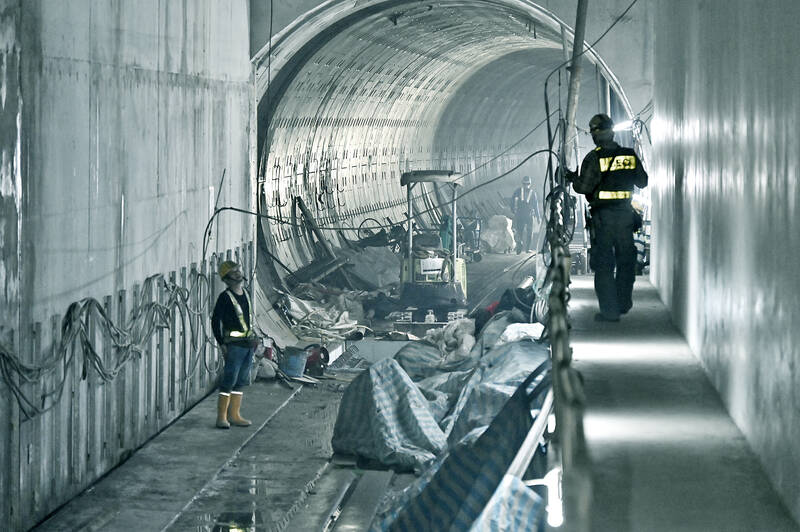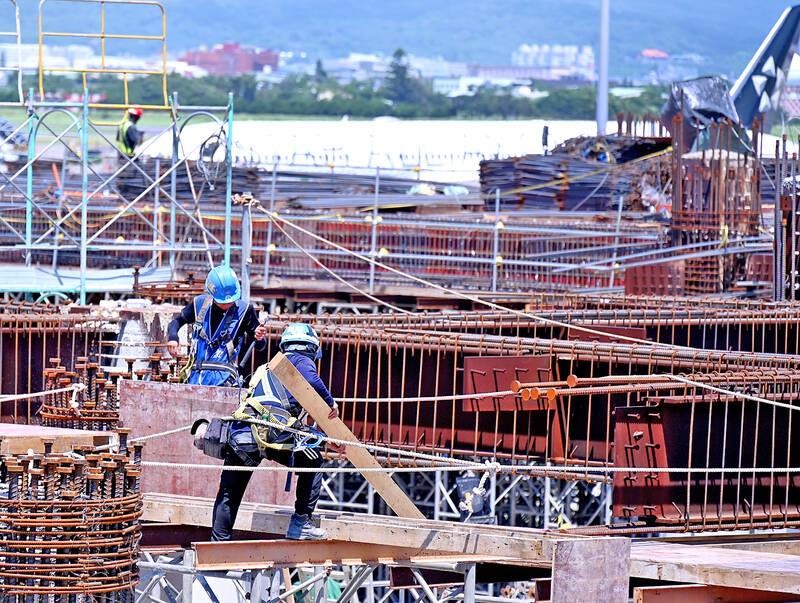In Taiwan there are two economies: the shiny high tech export economy epitomized by Taiwan Semiconductor Manufacturing Co (TSMC, 台積電) and its outsized effect on global supply chains, and the domestic economy, driven by construction and powered by flows of gravel, sand and government contracts. The latter supports the former: we can have an economy without TSMC, but we can’t have one without construction.
The labor shortage has heavily impacted public construction in Taiwan. For example, the first phase of the MRT Wanda Line in Taipei, originally slated for next year, has been pushed back to 2027. The government has invited bids for the second line, but at present firms are leery of bidding. Without a reliable supply of labor, they cannot contract for work to be done at a specific time.
IMPORTING TALENT

Photo: George Tsorng, Taipei Times
The international media, focusing on high tech, often reports on the high demand for talent in those industries. When the government speaks of importing talent, the high tech industries are often the implied context of demand, yet another way the government perceives labor importation as a way to chase status. Yet the construction industry also suffers from a profound lack of professional talent.
In its 2019 policy document Industry’s Talent Shortages: The Current Situation and Policy Response, the National Development Council (NDC) observed that 78 percent of employers in Taiwan face talent shortages. Engineers and IT technicians are hard to recruit, but many readers will be surprised to learn that those two categories follow talented sales staff as the most difficult to find, according to the NDC. The most serious shortage category of the 218,000 vacancies in 2017 was the gap of 120,000 mid-level technicians (technicians and associate professionals, craft and related trades workers and plant and machine operators). That shortage is the legacy of former president Chen Shui-bian’s (陳水扁) closure of the vocational schools that produced so much of the human capital for the miracle economy.
That trend has only accelerated. According to a Digitimes article from March, 104 Job Bank data showed 1.078 million job opportunities from 56,000 companies, “but the number of job seekers is only 595,000.” Low salaries are a major issue, but fundamentally, the demographic disaster predicted for so many years has arrived. Whatever industry one focuses on, the words “labor shortage” appear.

Photo: Chu Pei-hsiung, Taipei Times
The NDC report pointed out problems that have festered for years: poor immigration and residency systems, and low salaries. As Isabelle Cockel put it in a recent paper referring to migrant workers in Taiwan but truly describing everyone, “the developmental state of Taiwan continues to prioritize workers’ productivity over their rights.”
The NDC recommends tax abatements, though Taiwan already has one of the lowest tax takes on earth, and with an aging society higher taxes will be needed to care for the elderly. Taiwan’s Gold Card program, which brings in a tiny number of foreigners for display to the public like so many Golden Retriever puppies in a pet store window, doesn’t address the urgent problems industries face from the lack of mid-level professionals.
The construction industry faces unique demands. With factories returning to Taiwan from China demand for labor at all levels is high, but professionals in the industry are aging and leaving it and few young people are entering the industry. Parents do not want their children to enter the industry, which has a poor reputation and low social status. Government restrictions on migrant worker employment, to protect domestic employment, make it difficult to find laborers (and make employing runaways more attractive), while the Taiwan construction industry’s poor reputation in southeast Asia turns potential migrant workers off. Taiwan cannot match the pay and conditions that other countries offer.
Last July, the government finally permitted an additional 8,000 migrant workers to enter, with the potential to add another 15,000, but that will hardly begin to address the industry’s needs. It would need roughly 10 times that number to fill construction industry shortages.
Where are the young going? Consider that starting salaries for traditional jobs are around NT$30,000 a month, while food delivery starts around NT$40,000. Delivering food offers a flexible schedule, no boss, no office and, in the age of COVID-19, only fleeting contact, typically outdoors, with other people. It is easy to learn. There’s plenty of time to scroll through shorts on the phone while waiting for food. Working people of all ages, who might have gone into service jobs, are shifting to delivery.
The Internet is full of sermons on the behavior of the young, written by individuals who would never work in construction. When speakers blame culture change or lax individual morals and desire for convenience for individual choice-making, they are generally hiding a major structural crisis, in this case, of pay and working conditions.
LIMITED CHOICES
Debates about energy in Taiwan have swirled around power source choices: renewables or nuclear? Wind or solar? Geothermal? Few who discuss these issues have considered how the shape of the construction industry constrains choicemaking in the energy sector. For example, utility-scale solar development in Taiwan has been held up not only by regulatory and land acquisition issues, but also by the lack of competition in the market, according to a 2021 US-Taiwan Business Council Report.
Whether it chooses renewables or nuclear plants, the nation will need thousands of skilled workers and a robust and resilient construction industry. As with migrant labor, Taiwan competes with the global construction industry in acquiring resources such as construction sand to build energy plants at home. On-time delivery will be crucial because the government forecasts electricity demand to grow 12 percent by 2030 — which is now 5 years away (yes, like me, no doubt the reader is used to thinking of 2030 as a dim horizon, far in the future). Construction delays will further reduce Taiwan’s already thin electricity margins, and fear of delay will make firms shy about bidding on critical energy projects.
Finally, a resilient construction industry is a national security necessity. Someone has to pour the concrete for hardening Taiwan’s ports and transportation infrastructure, for creating strongpoints and missile sites. Someone has to rebuild damaged buildings. The need for maintenance and repair on transportation infrastructure alone is going to be mind-blowing. In 1944, Erhard Milch was demoted from overseeing Germany’s aircraft construction to fixing its broken transportation systems. He testified after the war that he pulled a million men out of factories just to fix the transport systems, when Germany already had 800,000 men working on repairing them.
Where will Taiwan find the skilled and experienced people it needs to keep things going, if China decides to attack? They have to be cultivated now.
The real crisis is that we’ve become inured to the labor crisis.
Notes from Central Taiwan is a column written by long-term resident Michael Turton, who provides incisive commentary informed by three decades of living in and writing about his adoptive country. The views expressed here are his own.

This month the government ordered a one-year block of Xiaohongshu (小紅書) or Rednote, a Chinese social media platform with more than 3 million users in Taiwan. The government pointed to widespread fraud activity on the platform, along with cybersecurity failures. Officials said that they had reached out to the company and asked it to change. However, they received no response. The pro-China parties, the Chinese Nationalist Party (KMT) and Taiwan People’s Party (TPP), immediately swung into action, denouncing the ban as an attack on free speech. This “free speech” claim was then echoed by the People’s Republic of China (PRC),

Exceptions to the rule are sometimes revealing. For a brief few years, there was an emerging ideological split between the Democratic Progressive Party (DPP) and Chinese Nationalist Party (KMT) that appeared to be pushing the DPP in a direction that would be considered more liberal, and the KMT more conservative. In the previous column, “The KMT-DPP’s bureaucrat-led developmental state” (Dec. 11, page 12), we examined how Taiwan’s democratic system developed, and how both the two main parties largely accepted a similar consensus on how Taiwan should be run domestically and did not split along the left-right lines more familiar in

Specialty sandwiches loaded with the contents of an entire charcuterie board, overflowing with sauces, creams and all manner of creative add-ons, is perhaps one of the biggest global food trends of this year. From London to New York, lines form down the block for mortadella, burrata, pistachio and more stuffed between slices of fresh sourdough, rye or focaccia. To try the trend in Taipei, Munchies Mafia is for sure the spot — could this be the best sandwich in town? Carlos from Spain and Sergio from Mexico opened this spot just seven months ago. The two met working in the

Many people in Taiwan first learned about universal basic income (UBI) — the idea that the government should provide regular, no-strings-attached payments to each citizen — in 2019. While seeking the Democratic nomination for the 2020 US presidential election, Andrew Yang, a politician of Taiwanese descent, said that, if elected, he’d institute a UBI of US$1,000 per month to “get the economic boot off of people’s throats, allowing them to lift their heads up, breathe, and get excited for the future.” His campaign petered out, but the concept of UBI hasn’t gone away. Throughout the industrialized world, there are fears that